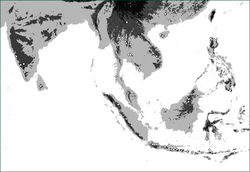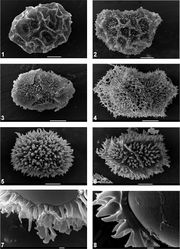Oleandra musifolia
| Notice: | This page is derived from the original publication listed below, whose author(s) should always be credited. Further contributors may edit and improve the content of this page and, consequently, need to be credited as well (see page history). Any assessment of factual correctness requires a careful review of the original article as well as of subsequent contributions.
If you are uncertain whether your planned contribution is correct or not, we suggest that you use the associated discussion page instead of editing the page directly. This page should be cited as follows (rationale):
Citation formats to copy and paste
BibTeX: @article{Hovenkamp2012PhytoKeys11, RIS/ Endnote: TY - JOUR Wikipedia/ Citizendium: <ref name="Hovenkamp2012PhytoKeys11">{{Citation See also the citation download page at the journal. |
Ordo: Polypodiales
Familia: Oleandraceae
Genus: Oleandra
Name
Oleandra musifolia Hovenkamp & Ho, 2012 – Wikispecies link – Pensoft Profile
- Oleandra musifolia Blume, Enum. Pl. Javae: 141. 1828. (as Oleandra musaefolium). Oleandra musaefolia C.Presl, Epimel. Bot.: 42. 1851. Fée, Mém. Foug., 5. Gen. Filic.: 304. 1852. Ching, Fl. Reipubl. Popularis Sin. 2: 321. 1959. Oleandra musifolia C.Chr., Index Filic.: 466. 1906. Backer & Posth., Varenfl. Jav.: 87. 1939. X.C.Zhang, Ching Mem. Vol.: 94. 1999. R.M.Tryon, Rhodora 102: 434, fig. 4. 2001. Type: INDONESIA. Java: Gedeh, Blume s.n. (holotype: L).
- Aspidium moritzii Kunze, Bot. Zeitung (Berlin) 6: 238. 1848., Kunze, Bot. Zeitung (Berlin) 9: 348. 1851. Oleandra moritzii C.Presl, Epimel. Bot.: 42. 1851. Fée, Mém. Foug., 5. Gen. Filic.: 304. 1852. Type: INDONESIA. Java: Zollinger 1306B (L, lectotype L 0317415, here selected).
- Oleandra geniculata Alderw., Bull. Jard. Bot. Buitenzorg Ser. 2: 23. 1914. Type: INDONESIA. Java: Docters van Leeuwen s.n.(holotype BO? not seen).
- Oleandra benguetensis Copel., Philipp. J. Sci. 46: 217. 1931. Fern Flora of the Philippines: 183. 1958. Type: PHILIPPINES. Baguio: Elmer 6286(holotype: US*).
- Oleandra whangii Ching, Bull. Dept. Biol. Sun Yatsen Univ. 6: 23. 1933. Type: CHINA. Guangxi: Sin & Whang 300 (holotype: SYS, not seen; isotypes: NY, PE, BM).
- Oleandra hainanensis Ching, Acta Phytotax. Sin. 8: 141, pl. 20 fig. 17. 1959. 141; Ching, Fl. Reipubl. Popularis Sin. 2: 322. 1959. X.C.Zhang, Ching Mem. Vol.: 91. 1999. Type: CHINA. Hainan: S.K. Lau 27326 (holotype: PE).
- Aspidium lomatopus Kunze, Bot. Zeitung (Berlin) 6: 238. 1848. Oleandra lomatopus C.Presl, Epimel. Bot.: 43. 1851. Fée, Mém. Foug., 5. Gen. Filic.: 304. 1852. Type: INDONESIA. Java: Zollinger s.n. (lectotype: K, here selected).
- Oleandra neriiformis auct. non Cav.:Bell, Flora of Australia 48: 446. 1998.
Description
Rhizome creeping, 5–8 mm thick, white waxy in the older parts, often supported above the substrate by unbranched stilt-like roots, dorsiventrally flattened, (strongly compressed, 4–6 mm wide when dry), with up to 10 cm long, curved internodes (only occasionally straight and then often much longer) terminating in a cluster of a few short phyllopodia, usually less than 5 (–15) mm long, often hidden by the scales, rhizome often innovating just below this cluster, lateral branches usually basal on the internodes, in opposite pairs; all parts in cross-section without or with few sclerified strands, roots scattered, with long unbranched aerial parts. Scales persistently covering the rhizome, peltate, 5–10 × 1–1.5 mm, appressed, with dark center and lighter brown acumen and margin, margin ciliate especially when young and with sessile glands. Fronds monomorphic, stipe 0.5–4 cm long, without dark colouration, with short, glandular hairs; lamina to 60 × 4.2 cm, linear, base cuneate to truncate or more or less rounded, apex acute to long-acuminate, texture thin-chartaceous, both surfaces with catenate, often glandular hairs 0.2–0.5 mm long; costa without dark colouration, on lower surface with inconspicuous, 1–3 mm long brown scales. Sori mostly in a single regular row close to the costa, sometimes more scattered over a 2–5 mm wide zone close to the costa or at a distance of up to 3 mm, indusium distinct, 1.5–2 mm wide, glabrous or glandular, sometimes setose. Sporangial stalk with glands below the sporangium. Spores with coarse confluent ridges, areolae with short pointed excrescences, perispore hollow, with internal baculae, outer layer not or hardly perforated.
Distribution
South China, Southern India, Sri Lanka, Thailand, Indonesia: Java, Lesser Sunda Islands, Sulawesi; Philippines: Luzon, Australia: Queensland.
Ecology
Mostly terrestrial or on rocks, less often as low trunk epiphyte, in various types of forests, often disturbed, sea level to c. 2000 m.
Discussion
ICN 60.8 specifies that the spelling of the original epithet “musaefolia” should be corrected to “musifolia”.
Aspidium moritzii is one of the two species distinguished by Kunze (1848)[1] among the collections under Zollinger 1306 (see also discussion under Oleandra neriiformis). The description conforms to Oleandra musifolia, and the specimen selected as lectotype for Aspidium moritzii is conform to the original description, and bears a label “Aspidium moritzi 1306B”. Aspidium lomatopus is based on a description and name in Kunze (1848)[1] that was evidently considered preliminary by Kunze, as he did not refer to this species in his later account (Kunze 1851[2]). A specimen in K is labeled “Zollinger 1306 b Aspidium moritzii Kze”, with a separate label “Oleandra lomatopus” in what may be Kunze’s hand. It is Oleandra musifolia, and is here selected as lectotype.
Oleandra musifolia is variable in the density of hairs is variable, and the distance of the sori to the costa. It can be distinguished from Oleandra cumingii mainly by the short phyllopodia (longer in Oleandra cumingii). Incomplete collections are easily confused also with Oleandra neriiformis but can often be recognized by the flatter, softer rhizome without sclerenchyma strands (rhizome more rigid, rounded, with sclerenchyma strands in Oleandra neriiformis) and by the catenate hairs with capitate or glandular apex (more acicular, not capitate in Oleandra neriiformis). Distinguishing these two species on basis of juvenile material, however, is difficult, and often impossible.
Taxon Treatment
- Hovenkamp, P; Ho, B; 2012: A revision of the fern genus Oleandra (Oleandraceae) in Asia PhytoKeys, 11: 1-37. doi
Other References
- ↑ 1.0 1.1 Kunze G (1848) In filices Javae Zollingerianas. Botanische Zeitung Berlin 6: 234-239.
- ↑ Kunze G (1851) Oleandra Botanische Zeitung Berlin 9: 345–349.
Images
|

